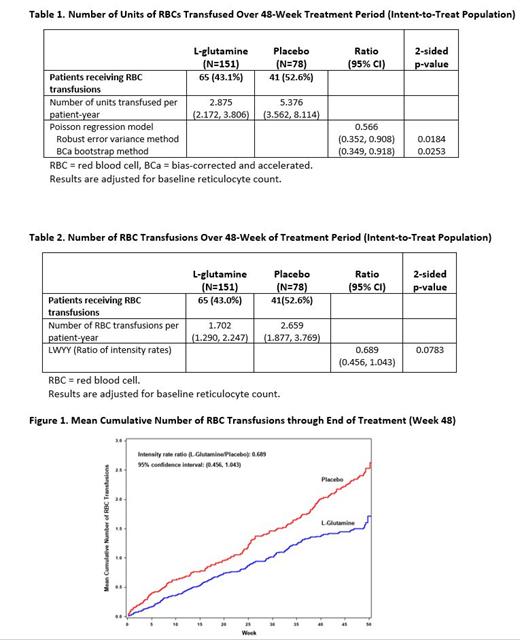Abstract
Introduction
The multicenter trial of L-glutamine in sickle cell disease enrolled a total of 230 patients, randomized 2:1, to receive L-glutamine (152 patients) or placebo (78 patients). Following 48 weeks of therapy, patients in the L-glutamine group had significantly fewer pain crises and fewer hospitalizations than those in the placebo group. Two thirds of the patients in both trial groups received concomitant hydroxyurea. The Multicenter Study of Hydroxyurea showed that the treatment group differed from the placebo group in the number of units of blood transfused and in the number of patients receiving transfusions. 1 Since an evaluation of transfusions was not pre-specified in the L-glutamine study, post-hoc analyses were performed on the number of units of red blood cells (RBC) transfused and on the number of transfusions that took place during the study.
Methods
For the number of units of RBCs transfused through Week 48, analyses of the transfusion dataset were performed using the Poisson regression model with both a robust error variance method and a bootstrap method with baseline reticulocyte count as a covariate. The bias-corrected and accelerated bootstrap method was based on 10,000 draws with replacement from the original data used to compute the 95% confidence interval (CI) for relative risk of the number of units of RBCs transfused and the p-value. For the number of transfusion episodes, the recurrent-event time analysis using the Lin-Wei-Yang-Ying (LWYY) method was employed to model the mean cumulative number of RBC transfusion episodes over the 48-week treatment period with baseline reticulocyte count as a covariate. 2
Results
There was a significant difference in the number of units of RBCs transfused in the L-glutamine treatment arm than in the placebo arm; 2.86 units per patient-year in the L-glutamine group vs. 5.38 units per patient-year in the placebo group (Table 1). There was a lower trend in the mean cumulative number of RBC transfusion episodes in the L-glutamine arm than the placebo arm during the 48-week treatment period; 1.702 RBC transfusion episodes per patient-year in the L-glutamine arm compared to 2.659 RBC transfusion episodes per patient-year in the placebo arm (Table 2, Figure 1).
Conclusion
The post-hoc analyses of the L-glutamine phase 3 clinical study in SCD indicated that, of patients requiring RBC transfusions, those assigned to L-glutamine required approximately 43% fewer units of RBCs compared to those assigned to placebo over the 48-Week period. The recurrent event-time analysis showed a favorable trend in the fewer number of RBC transfusion episodes for those receiving L-glutamine as compared to placebo. These observations are significant when considering the fact that 66% of participants in both arms of this study were on hydroxyurea therapy.
REFERENCES
1) Niihara Y, Miller ST, Kanter J, et al. A phase 3 trial of L-glutamine in sickle cell disease. N Eng J Med. 2018;379:226-35.
2) Lin DY, Wei LJ, Yang I, Ying Z. Semiparametric regression for the mean and rate functions of recurrent events. J Royal Statistical Society Series B. 2000;62(4):711-30.
Becerra: Emmaus Medical, Inc: Current Employment. Stark: Emmaus Medical, Inc: Current Employment. Niihara: Emmaus Lifesciences, Inc.: Current Employment. Callaghan: Agios Pharmaceuticals: Current Employment; BioMarin: Consultancy; Chiesi: Consultancy; Forma: Consultancy; Global Blood Therapeutics: Consultancy, Speakers Bureau; Hema Biologics: Consultancy; Kedrion: Consultancy; Pfizer: Consultancy; Roche/Genentech: Consultancy, Speakers Bureau; Sanofi: Consultancy; Spark: Consultancy; Takeda: Consultancy, Speakers Bureau; uniQure: Consultancy.


